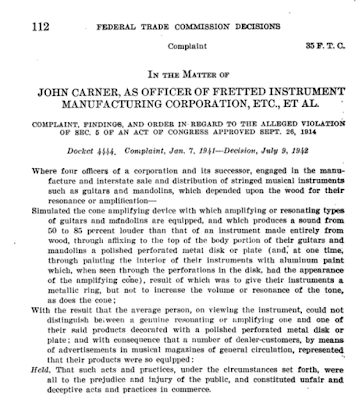 |
| "Melofonic" Branded Faux-Resonator Image Credit: Ebay - Clark's Music |
The Complaint
During the boom of American-built guitars sold through mail order catalogs and department stores, there was a desire to build more guitars as cheap as possible. Shortcuts were taken which sometimes resulted in deceptive marketing practices such as the very common "faux-flame" that was painted onto of thousands of budget guitars.
The Fretted Instrument Manufacturing Corporation (1935-April 1939) and United Guitar Company (June 1939-?) were targets of a 1941 complaint that that claimed both New Jersey manufacturers were involved in the production and distribution of fake resonator guitars [1].
 |
| Persons involved from both companies [1] |
A resonator, for those who don't know, is a guitar that has a circular hole cut into the top of the instrument to fit a metal cone, which acts like a speaker, and a metal cover to protect the thin cone from damage. There are also a number of structural changes inside the guitar to support this construction but I won't dive too far into those. The popular resonator guitars from the era were the National guitars which were build with all metal bodies and are associated with swamp blues. The FTC report claims that a "true" resonator results is "50 to 80 percent" louder than a regular flat top guitar.
These guitars did not contain metal cones but instead had the metal cover bolted onto a solid wood top with a silver circle painted underneath it to give the illusion of a cone. The silver paint would only be visible through thin slots in the metal cover making it unapparent to the uninformed consumer that the instrument is simply an imitation. To further the FTC's case against these manufacturers, they had also engaged in advertising claiming that the instruments were indeed true resonating guitars. The complaint outlined that the "purchasing public" would have no way of differentiating between these fake instruments and the true ones.
Any knowledgeable player would be able to strum one of these instruments and immediately know that something was amiss but the layperson might not have such experience. A player would note the lack of distinct "twang" in the tone and the volume that a resonator might have while a consumer might not know the difference.
It later goes on to say that Fretted Instrument Manufacturing Co started using the real resonator design from the Schireson Brothers in 1936 but ceased using it in 1937 due to threats of infringement. The manufacturers, not wanting to lose out on sales, continued to build lookalike instruments without the trademarked cone and sell them as if they were authentic instruments. The report says that "This latter practice was discontinued about the time the complaint herein was issued and has not been resumed."
 |
| Cutaway Schematic of a True Resonator Image Credit: Instructables.com |
These guitars did not contain metal cones but instead had the metal cover bolted onto a solid wood top with a silver circle painted underneath it to give the illusion of a cone. The silver paint would only be visible through thin slots in the metal cover making it unapparent to the uninformed consumer that the instrument is simply an imitation. To further the FTC's case against these manufacturers, they had also engaged in advertising claiming that the instruments were indeed true resonating guitars. The complaint outlined that the "purchasing public" would have no way of differentiating between these fake instruments and the true ones.
 |
| Incriminating evidence of intentional false advertising [1] |
 |
| Findings [1] |
It later goes on to say that Fretted Instrument Manufacturing Co started using the real resonator design from the Schireson Brothers in 1936 but ceased using it in 1937 due to threats of infringement. The manufacturers, not wanting to lose out on sales, continued to build lookalike instruments without the trademarked cone and sell them as if they were authentic instruments. The report says that "This latter practice was discontinued about the time the complaint herein was issued and has not been resumed."
Both companies were ordered to cease and desist such practices and file a report after 60 days outlining how they complied with the order. The Fretted Instrument Mfg Co was already defunct by that point and it appears the United Guitar Co ceased production of such instruments.











Good article - however National and Dobro were 2 separate companies - National produced mainly metal bodied with either 3 concave cones and a spider or a single concave cone driven by a central 'biscuit' bridge.
ReplyDeleteDobro built more wood bodied instruments with a convex cone driven by a spider which drove the cone from the edges.
Both these comments are generalisations.
Dobro has become a general name for a resonator guitar like hoover is for a vacuum cleaner.
I call my 3 resonator or resophonic guitars as none is a National or a Dobro.
Sorry to be pdeantic!
No problem, thank you for the correction.
DeleteThank you for this information. My son retrieved a guitar case from the curb last night, inside was a Melofonic guitar in rough shape along with sheet music dating from the 20's and 30's.
ReplyDeleteDo you have an Identity Theft Protection Service? How safe and secure is it? Your Identity is your life. Once compromised, you are at risk and your world shattered. Identity theft happens every day. You could be a victim! When your free annual credit report is not enough, you need something extra, a service that does not only monitor your credit score but also detects potential threats to your entire identity, uncovers existing fraud risks and issues you fraud alerts before your Identity and assets are harmed, and before you credit score starts sinking. fake id
ReplyDelete